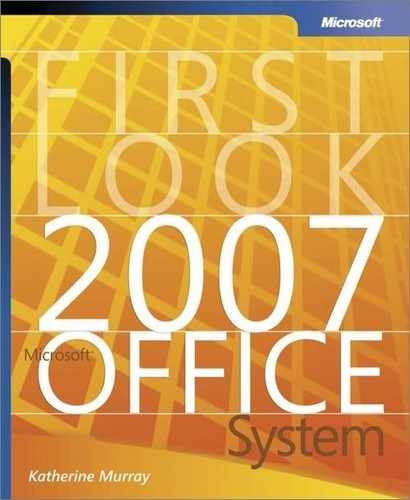New Views, New Tools
Perhaps the biggest news in Office Word 2007 is the story most of the applications share—the new look and feel of the program window. The user interface makes it easy to find just what you need (and only what you need) in the command tabs; the contextual tabs appear when you select an object; the command sets relate to the command tab that is currently selected. In addition to the new look, a new live Word Count toolbar enables you to know how long your document is getting and gives you a new full-screen viewing experience.
The Design of the New Office Word 2007 Window
The command tabs on the Office Word 2007 user interface are arranged according to the sequence of tasks you are likely to accomplish as you move through the different stages of document creation (see Figure 4-1). Here’s a quick rundown of the command tabs and what you’ll find in each one:
The Home tab includes commands related to the Clipboard, font selections, paragraph settings, styles, and editing.
The Insert tab includes what you need to add pages, tables, illustrations, links, headers and footers, text objects, and symbols in your document.
The Page Layout tab contains the commands for working with themes, page backgrounds, and paragraph spacing in your document. Additionally, you choose page setup options and arrange the order of elements on your page using this tab.
The References tab includes special elements you will use when you create longer or more complete documents. On this tab, you’ll find what you need to create a table of contents, footnotes, citations and bibliographies, captions, an index, and a table of authorities.
The Mailings tab is a new addition in the Office Word 2007 interface. Here you can find everything you need related to creating, previewing, and producing a mail merge project.
The Review tab houses all the commands you need for checking (spelling, thesaurus, and more) your document and sharing it with others for review. Here’s where you find commands for adding comments, tracking and working with changes, comparing versions, and protecting the document.
The View tab is where you’ll find all the options for displaying your document in different ways: from basic document views, to a set of display tools for adding rulers and gridlines, to options for working with multiple documents in multiple windows.
View controls are placed in the bottom-right corner of the Office Word 2007 window so you can move among views easily. The new Zoom slider is a great addition, enabling you to magnify or reduce the display incrementally while you work.

Tip
|
| For more about working with the different features in the new 2007 Microsoft Office system user interface—including command sets, contextual tools, live preview (which really shines in Office Word 2007), dialog launchers, and more—see Chapter 2, “A New Look.” |

